Tips And Strategies For Organizing a Successful Meeting: Your Complete Guide
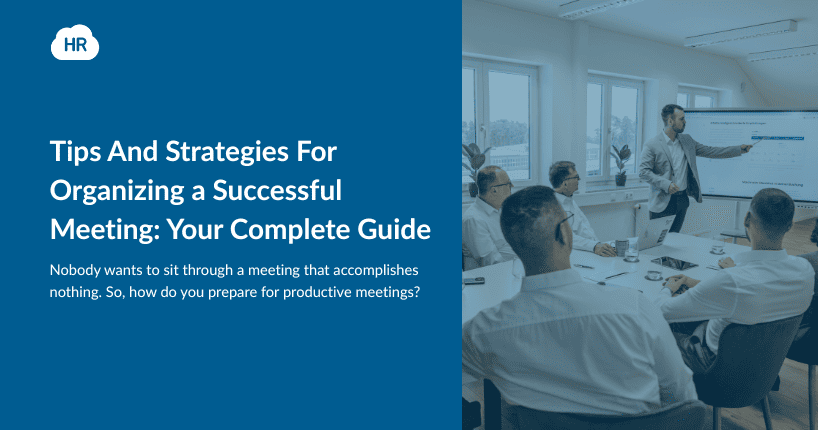
- Get Prepared Before Your Meeting
- Six Steps to Successfully Organize Productive Meetings
- 1. Set the Purpose and Goals of Your Meeting
- 2. Plan an Agenda Beforehand
- 3. Get Attendees Prepared for Your Meeting
- 4. Implement Effective Meeting Tips
- 5. Foster Meeting Collaboration and Communication
- 6. Ensure Meeting Accountability and Follow-Up
- Five Tips to Boost Meeting Productivity
- 1. The Real Problem Isn't Time
- 2. Keep Meetings to a Minimum and as Brief as Possible
- 3. Establish a No-Smartphone Zone
- 4. Limit the Number of People Who Attend
- 5. Make a List of Action Items at the End of Your Meeting


 Cut onboarding time
by 60%—here's the
Ultimate Checklist
that helped do it.
Cut onboarding time
by 60%—here's the
Ultimate Checklist
that helped do it.

After leaving an hour-long meeting, how often have you heard people say, "That could have been an email"? Employees feel their time is squandered. With limited hours and too much work, ineffective meetings cause employees to become more stressed and irritated.
The reality is that nobody wants to sit through a meeting that accomplishes nothing. Meetings, on the other hand, aren't all unpleasant. Face-to-face interaction boosts creativity, encourages teamwork, and can help teams develop solutions that they would not have come up with on their own. Unfortunately, meeting expenses account for a little over 1% of total revenue for most businesses.
So, how do you prepare for productive meetings and implement effective meeting strategies? Learning how to run an effective meeting is crucial for any business leader or manager. Understanding the essentials of meeting facilitation, various meeting types, and effective meeting tips can significantly improve your approach to leading meetings and ensure more effective meetings overall.
A primary focus is ensuring that everyone touched by the problem has a voice and is actively engaged in the process. This ensures that everyone has an excellent time at the meeting and has diverse viewpoints in your discussions and conclusions. In addition, everyone should feel heard, understood, and optimistic about the group and any plans or decisions you've made during a meeting. Effective meeting planning involves considering these aspects to create a productive meeting environment and enhance meeting productivity.
Get Prepared Before Your Meeting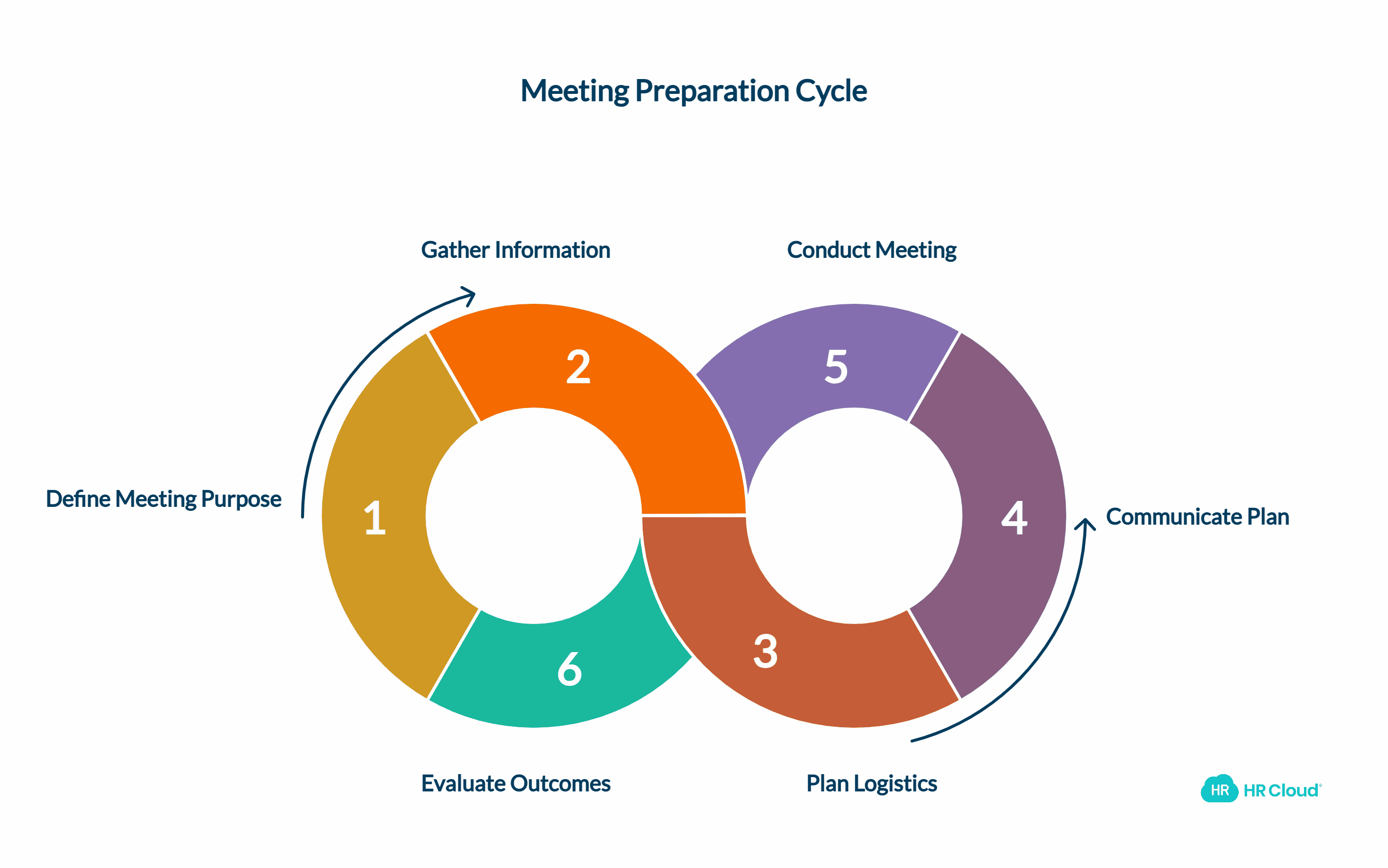
Meetings are commonplace in the workplace. However, unlike a trade fair or a teambuilding activity, a meeting is a generic term that may describe any gathering of individuals. Proper meeting preparation is key to ensuring more effective business meetings. Understanding how to prepare for a business meeting is crucial for success.
What distinguishes a meeting from an event? Rectangles and squares are similar to meetings and events. However, not all meetings are events, and not all events are meetings. Meetings are usually held for educational or business purposes, and the magnitude and sense of gatherings might vary.
Meetings are held to communicate information, whether for business or education. For example, a new venture, a project update, or HR training could all be on the cards. The most efficient approach to achieving a common goal is to gather, whether digitally or in person, a meeting. Take a look at the video hosting sites and search for information about your meeting's main topic, gathering as much versatile information as possible, which will help you in the planning process.
Whether it’s a sales pitch meeting for a series of latest technology trends or an HR meeting for new recruitments, pay close attention to the planning process. Every meeting starts with a vision, but to analyze costs and make efficient planning decisions, you'll need to translate your vision into words and statistics. So start with the fundamentals of planning, such as who, what, when, where, and why. This approach is essential when considering how to prepare for effective business meetings and establishing a clear meeting purpose.
Open a document that is available to the entire team and allows each member to view the others and the broader picture. Next, make a list of the essential tasks first, and then fill them out as much as possible in individual stages. In the planning process, it's critical to specify the timetable and priorities. Effective time management and meeting scheduling are crucial components of successful meeting planning and can help save time during meetings.
The gathering's goal needs to be highly explicit. For example, if it's a business meeting, the items on the agenda that will be discussed must be evident. After everything has been organized, the next step is to choose a location for the meeting. It is not an easy undertaking when planning meetings for a large group of people. If the meeting is held remotely, focus on technical issues that may arise, create solid passwords if there’s a need for a signup, and cancel background noise. Considering technology for running effective meetings can greatly enhance the meeting experience and overall meeting structure.
If your company holds many meetings requiring selecting locations, scheduling travel, and managing food and beverages across multiple offices, streamlining your meeting process can be a good idea to streamline your meeting process. “Standardizing a meeting program allows you to keep track of meeting activities, automate sourcing and budgeting to save time, and improve compliance and efficiency by using standard methods,” says Craig Anderson, Founder of Express Dentist. This approach contributes to overall meeting efficiency and effectiveness, and can help you run better meetings.
Six Steps to Successfully Organizing Productive Meetings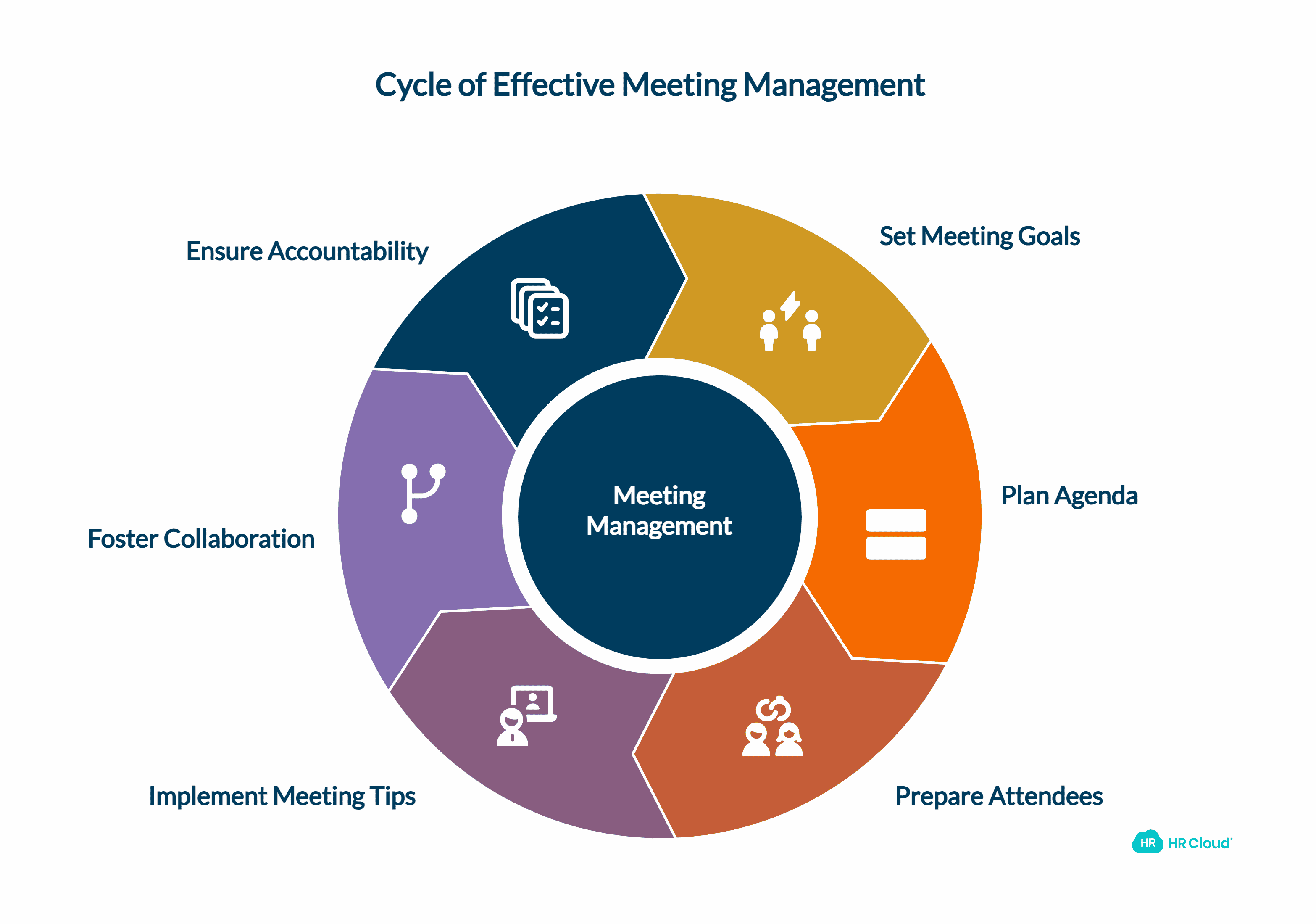
Meetings are essential for several good reasons. First, because there is a set time for communication, meetings help build stronger team relationships. Whether you’re selling online courses or launching the latest gadget, you will need to organize a meeting to deal with its proceedings. Understanding different meeting types can help you tailor your approach for maximum effectiveness and improve meeting engagement.
Any major company decisions should always be discussed face-to-face. Then, instead of using a video call, you give the decision and the people involved the time and respect required to resolve it. Successful meeting planning can be complex, but it can make a huge difference once accomplished.
Here are a few steps to successfully organize productive meetings and run productive meetings:
1. Set the Purpose and Goals of Your Meeting
Setting a meeting goal may appear simple, but there's much more to it than that. Setting meeting objectives in advance to work toward the time given for the meeting is critical to running and participating in an effective meeting.
Meeting objectives, direct your discussions to stay on track, on the subject, and as productive as possible. Whether you have a few meeting objectives in mind or a significant decision, it's critical to be organized, prepared, and adhere to your plan using a collaborative agenda template. Consider sharing your meeting goals with attendees in your informational or even welcome emails if they are new. This way, they will feel more engaged in the meeting and show more interest. Establishing clear meeting outcomes from the outset is a crucial aspect of effective meeting planning and contributes to overall meeting productivity.
Meeting objectives are essentially the outcomes you wish to achieve by the end of the meeting. You can have numerous minor meeting objectives or a primary aim, depending on the nature of the project you and your team are working on.
Joey Sasson, Vice President of Sales & Logistics at Moving APT, says, “Your meeting objectives should be clearly stated in your schedule so that you may plan all of the procedures necessary to achieve one or more goals by the end of your team meeting.”
Unfortunately, if your team isn't dedicated to sticking to a meeting agenda, the meeting will not go well. So make sure you seek your team members' opinions and that their voices are heard before you decide the topics you'll be covering to fulfill your meeting goal(s). This collaborative approach is key to conducting effective meetings and enhancing meeting communication.
Setting at least one goal for each meeting is critical because failing to do so may cause you to lose focus. In addition, your team members and you are likely to hold opposing viewpoints on the most vital or pressing issues to solve. This is why planning ahead of time to create a collaborative agenda or soliciting suggestions is critical. For example, if the meeting is about business competitions, you'll have to be ready with all the relevant objectives and feature questions, such as "Who are they?" "What are their strengths and weaknesses?" etc.
It's crucial to know what attendees think is significant to bring up and that their opinions are taken into account, because there may be concerns or points of interest that you weren't aware of otherwise. Furthermore, having a common goal will draw you and your team closer together as you strive for success.
Here are some common and significant types of meeting goals to be aware of when planning and implementing critical corporate goals:
-
Problem-solving
-
Adjustments and retrospection
-
Planning
-
Decision-making
-
Getting work done
-
Relationship and culture-building
-
Sharing feedback or reviewing work
“Setting defined meeting goals will make your team feel more driven to work together to achieve collective success if your team is goal-oriented,” notes Jonathan Ben Zvi, CEO of All Forward. In addition, understanding the various sorts of meeting objectives will enable you to customize how you set meeting goals to the purpose of your discussion.
After the meeting, make sure you go through your results to see what you've accomplished. Then, consider why you haven't been able to fulfill the meeting target you set for yourself. For example, was the meeting's purpose well-defined? This reflection is an important part of the meeting cycle and contributes to continuous improvement in meeting effectiveness and overall meeting evaluation.
 Discover how our HR solutions streamline onboarding, boost employee engagement, and simplify HR management
Discover how our HR solutions streamline onboarding, boost employee engagement, and simplify HR management
2. Plan an Agenda Beforehand
Arrive with a positive mindset. Encourage everyone to participate. Start an online timer and watch the time to ensure that the meeting ends on schedule. Effective time management is crucial for conducting effective meetings and can help save time during meetings.
While such abilities are helpful once you're in the room, the seeds of highly productive meetings are planted well before the meeting date, even before the invitations are sent out.
It all starts with a well-planned meeting agenda.
Great meetings take place because they are required to achieve an important goal. Before a leader can select who should attend a meeting and how it should be run, specify the meeting's purpose. Meeting agendas serve as a tool for team preparation before the meeting and a guide throughout it. A well-structured agenda is a key component of effective meeting planning and contributes to overall meeting structure.
An Agenda:
Meeting goals and conversation topics are clearly stated in a compelling meeting agenda. It is written to assist team members before, during, and after the meeting while delivering all the required information to ensure success.
An agenda is a listing of meeting activities and conversations that will be addressed in your meeting. It is vital to work that out before the meeting begins. They're organized logically, usually as a list or a group of bullet points.
You should thoroughly plan an All-Hands gathering to optimize the team's time together, whereas a brief one-topic huddle may require no plan.
On the other hand, meeting minutes often start with the schedule and fill in the blanks with further information about what happened during the meeting, such as decisions and future steps.
A plan could include a question to be answered, for example, "Discussion: Should we postpone our team-wide retreat until 2022?"
Creating a meeting agenda:
The first step in building an effective meeting plan is deciding on the type of document to utilize. This determines how simple it will be for meeting participants to develop, distribute, and refer to your schedule.
You can format your agenda in a variety of ways, including:
-
Word document
-
Google Doc
-
PDF
Consider whether anyone else will need to add to the agenda or have the opportunity to remark on it. If that's the case, sending the schedule will cause tension; therefore, a more collaborative approach will be beneficial.
Also, if you think of using something fun, such as the “best I can do is meme,” then use that skill to create a meme relevant and relatable to the situation and present it as an icebreaker at the beginning.
For instance, you could wish to create a lovely agenda PDF to print before a meeting. However, if you choose this format, it will be difficult or impossible for others to make agenda changes or fill in their parts with greater detail if they give a presentation at your meeting. As a result, a shared document is frequently preferred.
Pro-tip:
Early agenda drafting provides several advantages, including reducing meeting goals, which helps determine who needs to be there and predicts a reasonable meeting duration for the conversation topics included. In addition, when you outline a meeting before sending out invitations, you're more likely to have people arrive prepared because they'll know what's on the agenda. Finally, it's essential to plan everything, whether you need to sign a shareholders’ agreement during the business meeting or make a small fundraising while meeting attendees.
In most cases, imposing meeting goals and conversation topics on your attendees on the day of the meeting is counterproductive.
For weekly meetings with low-stakes decision-making objectives, this might work. However, a better strategy is to develop the practice of sharing well-thought-out meeting agendas that allow attendees to offer revisions. When schedules are transferred, and participants may add to them, they become more powerful.
Whether a vital piece of information needs to be provided to inform the meeting, additional time must be allotted to a topic that a team member believes is more complex than it appears. Allowing early attendee engagement builds a strong foundation and gives attendees ownership.
Furthermore, planning a schedule gives the meeting host plenty of time to arrange their thoughts and goals and ensure that nothing crucial is left off the agenda on the meeting day.
3. Get Attendees Prepared for Your Meeting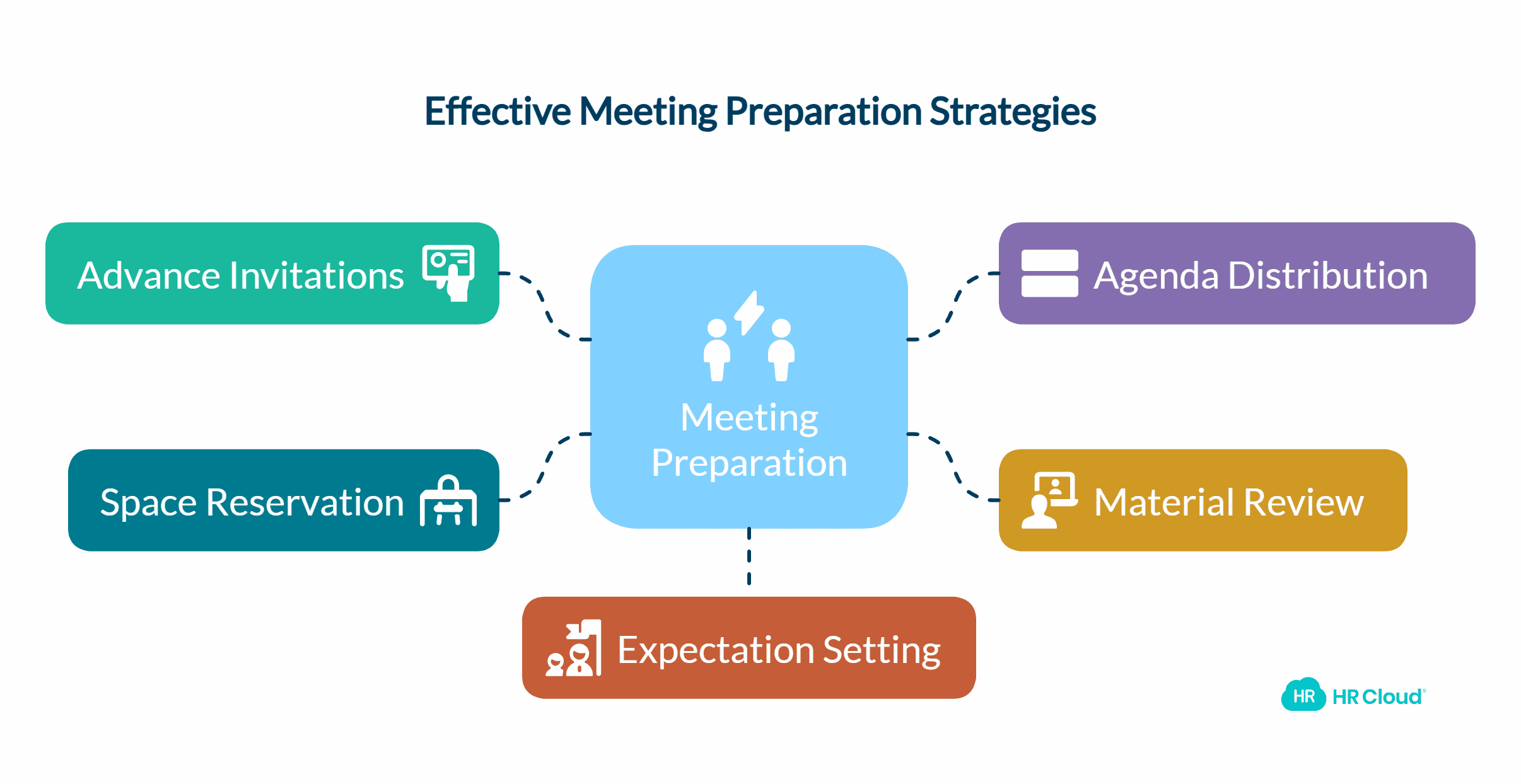
Because most individuals are unprepared, most meetings are a disaster. They haven't considered why the meeting is taking place or what they want to achieve. Worse, they are afraid to take charge and stop others from stealing time. Proper meeting preparation is essential for conducting effective meetings and ensuring meeting productivity.
Here are five things to complete to get attendees prepared for your meeting:
Send invitations in advance: Meetings should not be rushed. Nobody enjoys being invited to a meeting on the same day. Therefore, a meeting request email should be sent out at least 2–3 days. You can use social listening tools to analyze how your attendees would like to receive the invitation and what they want to discuss to make your meeting more productive. Effective meeting scheduling involves giving attendees ample notice.
Distribute an agenda: A meeting with no plan is nothing more than a free-for-all. Make a schedule and give it to the attendees to be ready to debate the issues.
If any advance materials need to be reviewed, please make sure you deliver them early enough so that attendees have time to study them. If you don't, your meeting will devolve into a "reading session." This is not an excellent way to spend anyone's time. You can also share your agenda online. If you do so, don’t forget to include the right call-to-action phrases so that attendees know what they are supposed to accomplish.
Reserve meeting space: We've all tried to attend a meeting only to find out at the last minute that the invitation does not include a meeting location. Ensure you have enough meeting space for the number of people attending and the work needed. This is an important aspect of meeting logistics.
Set meeting expectations: Setting the expectation of "What is the meeting's goal?" is maybe the most critical thing you can do before the meeting. People prefer to know why they are attending in advance. It gives the meeting direction. Make your meeting topic as specific as possible. "Catch-up" is not an appropriate topic for a meeting. "Briefing on the progress of Project XYZ" is far more effective and will result in a more productive meeting. Clear meeting ground rules can help set these expectations and contribute to the overall meeting structure.
Suppose you don't prepare ahead of time. Then, the majority of meetings are doomed from the start.
Meetings are so inefficient in many companies that they are considered the single biggest time-waster in the office. If you plan ahead of time for your meetings, you'll be able to make better use of everyone's time and run better meetings.
There is no justification for not learning about the individuals you are meeting. You should know who is at the table, whether it's a one-on-one meeting or a conference table of ten. Please make a list of attendees and look them up on the Internet. Check over their LinkedIn profile and even their Facebook group to get a sense of who they are and how they can add to the conversation. The time you put in up front will save you time on introductions and provide you with valuable information in the event of a problem.
The majority of meetings ramble because people wait until the last minute to figure out what they want to get out of their time. Even if you're the only one who knows what needs to be done, you may direct the results to match your demands and declare success once the goals are completed.
Prepare your preferred agenda ahead of time and present it to the group at the beginning of the meeting. People will most likely embrace your proposal or, at the very least, voice any essential changes that can be immediately agreed upon. So, pick your business objectives for the meeting and lead with them.
Rather than waiting for the bombs to go off, prepare yourself for the drama that may happen. Consider which battles are worth your time and effort and which you are ready to give up. You can keep calm and proceed toward a resolution fast if you are mentally prepared for the emotion and dispute.
You shouldn't wait until the meeting ends to fix every issue. Instead, you will save time for the attendees to identify potential concerns and resolve them before the meeting. Then, with enough information, you will be able to eliminate the necessity for the meeting.
Ascertain that everyone understands why the meeting is necessary and the more significant impact on the parties involved. This is different from the tactical meeting objectives in that it is about understanding how this meeting fits into the overall strategy. For instance, if your meeting's general purpose is to discuss the benefits of e-commerce development on your business, then it’s obvious that the meeting should be prepared around this topic, with a lot of information and opinions included. If people aren't clear on this, the effort and outcomes will be disjointed at best and ineffective at worst.
Before entering the meeting, set aside time to take action that will benefit from the discussion. Most people don't think about follow-up and follow-through until after the session has ended. If you budget time that becomes unproductive, you can quickly redistribute it to more critical tasks. This is why it’s essential to plan your further steps and ensure proper meeting follow-up.
4. Implement Effective Meeting Tips
To run better meetings and ensure meeting productivity, consider implementing these effective meeting tips:
1. Start and end on time to respect everyone's schedule
2. Assign meeting roles such as facilitator, timekeeper, and note-taker
3. Encourage active participation from all attendees
4. Use visual aids to enhance understanding and engagement
5. Summarize key points and action items at the end of the meeting
5. Foster Meeting Collaboration and Communication
Effective meetings rely heavily on collaboration and open communication. To enhance these aspects:
1. Create an environment where all participants feel comfortable sharing ideas
2. Use collaborative tools for real-time document editing and idea sharing
3. Encourage constructive feedback and discussion
4. Practice active listening and ensure all voices are heard
5. Address conflicts or disagreements professionally and productively
6. Ensure Meeting Accountability and Follow-Up
To maximize the impact of your meetings and drive results:
1. Clearly assign action items and responsibilities
2. Set deadlines for follow-up tasks
3. Distribute meeting minutes promptly after the meeting
4. Schedule check-ins on the progress of action items
5. Use the outcomes of one meeting to inform the agenda of the next
-
By implementing these strategies and focusing on meeting essentials, you can significantly improve your meeting leadership skills and conduct more effective meetings. Remember, the key to running an effective meeting lies in thorough preparation, clear communication, and consistent follow-through. With practice and dedication to these principles, you'll be able to save time during meetings, enhance meeting productivity, and achieve better outcomes for your team and organization.
Five Tips to Boost Meeting Productivity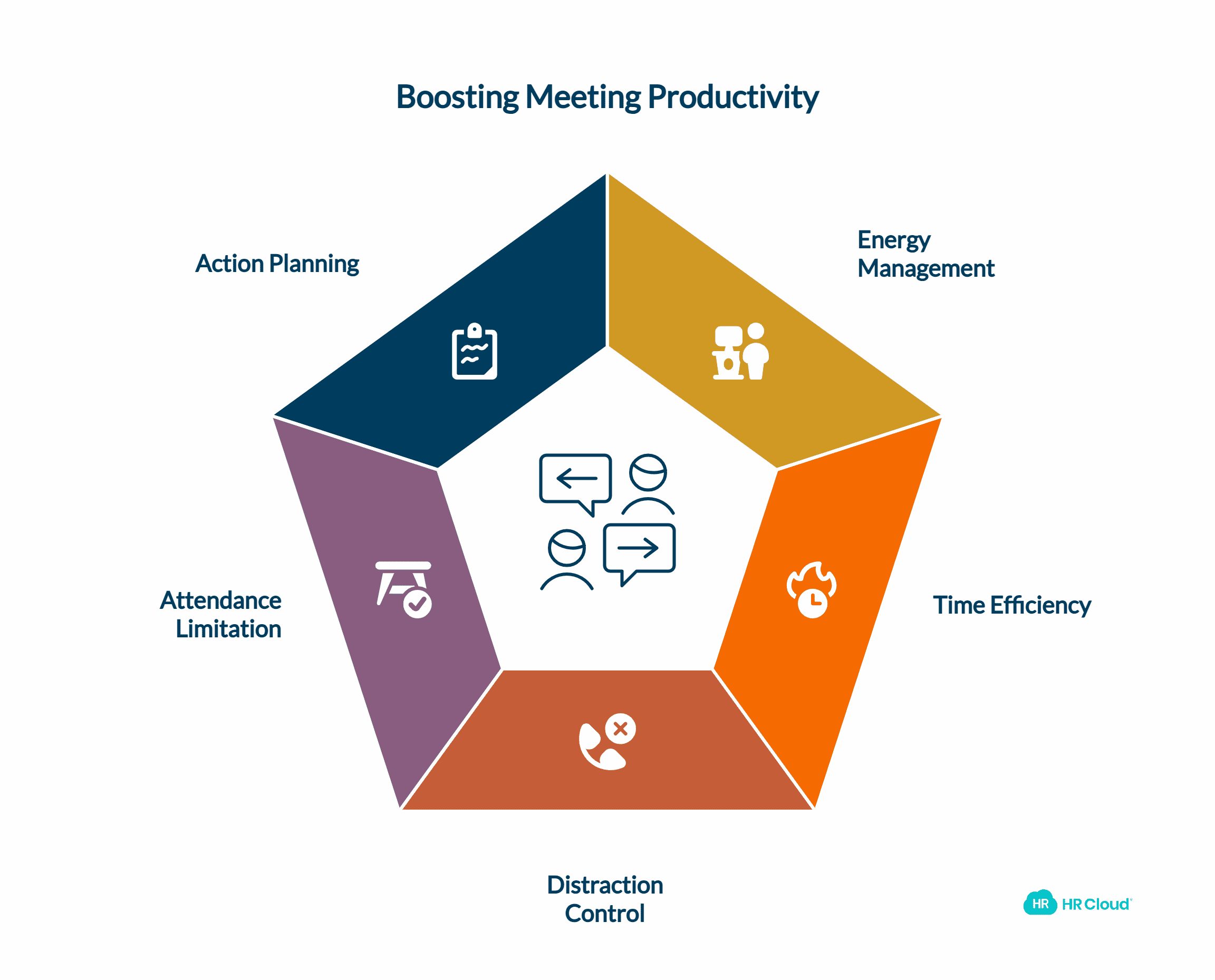
Ineffective meetings are more than just a tedious experience for your employees; they can also cost your company money. Unproductive meetings have opportunity costs in the form of pay and office-related costs, and indirect costs such as lost employee work time and reduced employee satisfaction, which leads to higher employee onboarding programs.
Meetings are nearly entirely virtual these days, so many employees and leaders are navigating a new manner of attending and holding meetings, making productivity even more difficult.
1. The Real Problem Isn't Time
Increasing the effectiveness of your meetings is as much about optimizing your energy levels as it is about maximizing the amount of time you spend on them. Unfortunately, many employees are stressed out about not having enough time to perform their allocated responsibilities, and they claim that meetings rob them of this valuable resource.
Consider staff energy levels while choosing the schedule and duration of your meeting to reduce the negative connotations associated with meetings. If you're planning a lengthier team meeting, take breaks to ensure that productivity remains at its peak. While virtual meetings may appear to be less taxing on your employees' energy levels, arranging meetings at the proper time is just as vital as holding them in person. All you have to do is deliver the right message through SaaS webinar email templates if it’s à webinar-like meeting, choose the right employees for the meeting, etc. Work patterns and schedules, as well as meeting practices, should be consistent for your personnel.
2. Keep Meetings to a Minimum and as Brief as Possible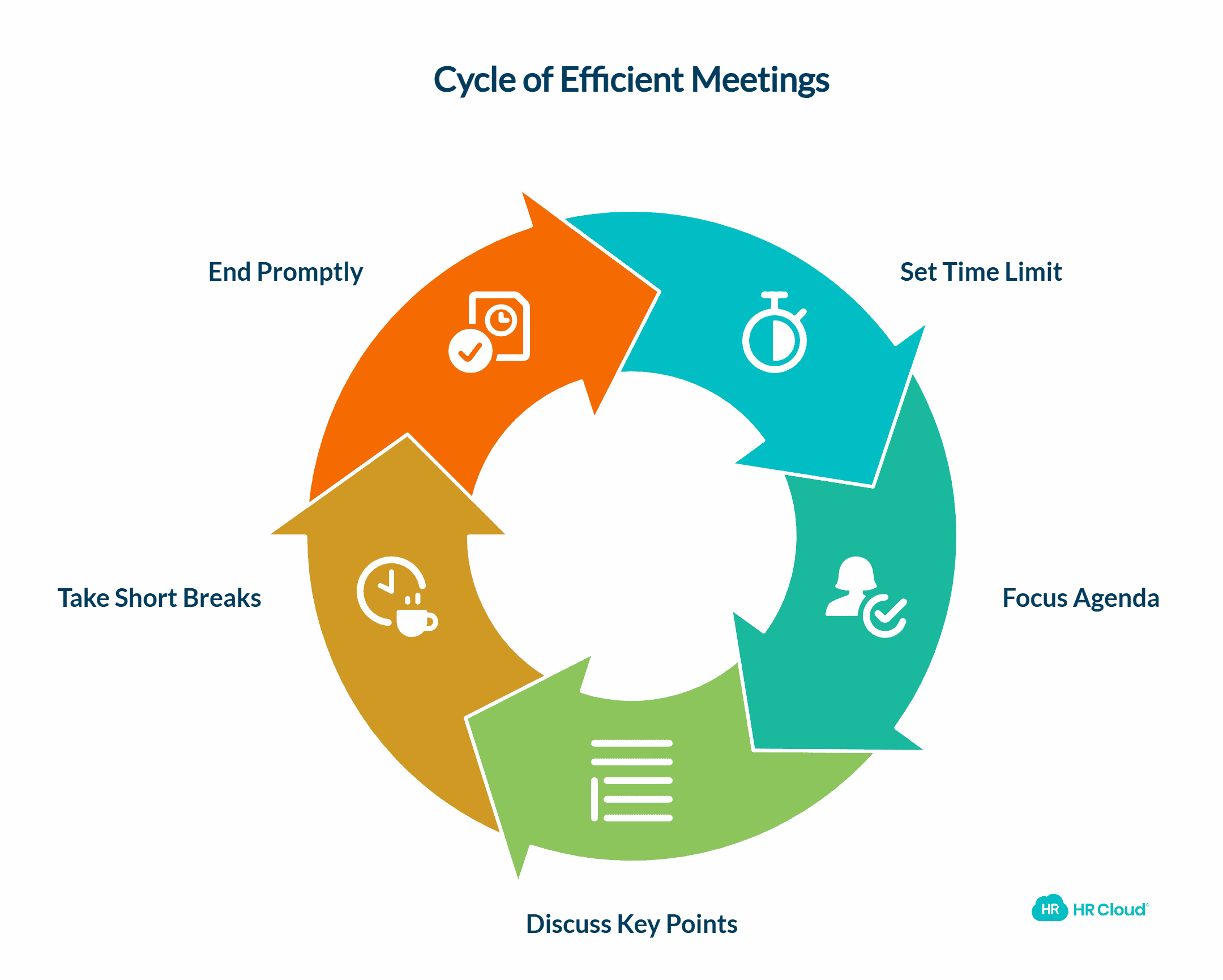
"Work expands to cover the time available for completion," according to Parkinson's Law. This is also true for your business meetings. For example, if you arrange an hour-long session, your team will fill it up quickly to stay on schedule.
This should caution that you're not getting the most out of your meetings. Instead of filling up a meeting time, try to make your meetings as brief as possible. This keeps your agenda focused and free of distractions and filler. If, for example, your meeting is about whether or not you should integrate a WordPress chatbot on your website, make sure you discuss the pros and cons, how you can acquire one, and what you should focus on. Similarly, you could also discuss how to train ChatGPT on custom data for your business needs. This will save you from wasted time and distractions.
Setting a meeting time limit of 10 or 15 minutes can be beneficial. According to studies, our attention span is only 10 to 18 minutes. Some businesses even use time-tracking tools like a timer or an incentive to complete on time. Make it a rule never to schedule a meeting that will last more than 30 minutes. Work in short pause halfway through the meeting to keep your team members' complete attention throughout. Do not stretch your chatter to fill up space if you run out of time before the clock. Instead, make sure that everyone has gotten all of the information they need and then let them get back to work on their own.
3. Establish a No-Smartphone Zone
Both meeting leaders and attendees find cell phones or tablets during meetings to be inconvenient. In addition, many people think that it demonstrates a lack of respect for the speaker and their colleagues. Still, it indicates that complete involvement is patchy or missing, which might deter others from being fully present and attentive during meetings.
To improve employee engagement, make your meeting spaces a smartphone-free zone; urging individuals to put their phones outside in a basket or at their desks will help reduce any distractions and ensure that all attendees are fully engaged.
For other employees, remote work can be an even more distracting working style, exacerbated by a lack of control over using their smartphones for non-work-related objectives. In such cases, coworking spaces are the best solution for working effectively with the whole team and making the working process more flexible. Even when employing technology to hold the meeting, keeping meetings smartphone-free time for all team members appears to enhance overall efficiency.
4. Limit the Number of People Who Attend
Limiting the number of guests invited is a less typical strategy used by companies to increase meeting productivity. For example, Google, one of the world's most successful firms, is known for allowing no more than ten individuals in a conference at any given time.
You can keep your meeting controlled and targeted toward the exact conclusion you want by limiting attendees and inviting only vital persons. Consider various email marketing tools for startups to make your invitations go straight to the people you need for your meeting. However, when you ask too many individuals, you risk most of your audience not having a clear voice and not focusing on their everyday activities.
A powerful strategy to maintain your meetings cost-effectively is to limit the number of attendees. Every employee is paid on an hourly basis; adding up the hourly salaries of all attendees yields a general hourly fee for a meeting. Thus, keeping the number of people in a meeting to a minimum reduces the direct costs of holding the meeting. It also ensures you have the people you need for the meeting, which, in turn, helps you build an online community based on employees interested in company discussions.
5. Make a List of Action Items at the End of Your Meeting
You should always set out a few minutes at the end of any fruitful meeting to summarise what has been covered. Then, ask the following questions:
-
What is the timeframe?
-
What are your plans for the future?
-
Who is responsible for them?
Depending on how big your audience is, adjust the timeframe for this reflection period. As a general rule, allow 30 seconds for every meeting attendee to ensure that everyone has a good understanding of these three questions. Everyone should have a clear awareness of their responsibilities and be accountable to other meeting attendees when a meeting ends.
Send out a summary of the minutes and any particular action items discussed at the end of the meeting. Add the DRI to each of these action points (Directly Responsible Individual). This ensures that the meeting's objectives are met.
Conclusion
It all comes down to preparation, organization, and respect when it comes to planning a great meeting. Take the time to figure out why you want to hold a meeting, rather than just doing it for its sake. Meetings can generate new ideas, uncover solutions to complex problems, address difficulties, and foster camaraderie, among other things.
Management software like Hirebook will guide organizers with the main things teams should know while leading any meeting.
Stay organized when making plans. Provide background information, an agenda, and a timely start to the meeting. In the end, it's all about treating your coworkers with respect. The meeting will impact you if you provide them with the tools to succeed and make the most of their time.
Every day, meetings take place. So why not make the next one even better?

Keep Reading
The Hidden Metrics of Frontline Success: Beyond Engagement Scores
"What gets measured gets managed, but what gets measured well gets transformed." — Peter
Embracing Diversity: Recognizing Different Cultures in the Workplace
Workplaces today reflect the incredible diversity of the world around us. People bring
From Manual to Automated: A Complete Guide to Digitizing Employee Onboarding for Large Organizations
Sarah Chen, Director of HR at a 7,000-employee healthcare organization, starts her Monday
Like What You Hear?
We'd love to chat with you more about how HR Cloud® can support your business's HR needs. Book Your Free Demo

Build a Culture of Recognition. Boost Engagement. Guaranteed.
Workmates empowers employees to stay informed, connected, and appreciated—whether they’re on the front line, in the office, or remote. Recognition drives 12x higher engagement.Trusted by industry leaders in every sector




Cut Onboarding Costs by 60%.
Take the confusion and follow-ups out of onboarding with automated workflows, digital forms, and structured portals—so new hires ramp faster 3X quicker.Trusted by industry leaders in every sector




